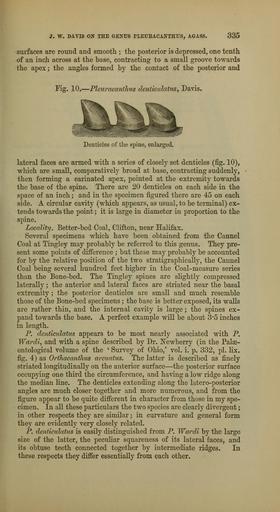MAKE A MEME
View Large Image

| View Original: | The_Quarterly_journal_of_the_Geological_Society_of_London_(12960575004).jpg (1750x3200) | |||
| Download: | Original | Medium | Small | Thumb |
| Courtesy of: | commons.wikimedia.org | More Like This | ||
| Keywords: The Quarterly journal of the Geological Society of London (12960575004).jpg J W DATIS OX THE GEXTJ8 PLEUR ACANTHUS AGASS 335 <br> surfaces are round and smooth ; the posterior is depressed one tenth <br> of an inch across at the base contracting to a small groove towards <br> the apex ; the angles formed by the contact of the posterior and <br> Fig 10 ” Pleuracantlius denticidatus Davis <br> Denticles of the spine enlarged <br> lateral faces are armed with a series of closely set denticles fig 10 <br> which are small comparatively broad at base contracting suddenly <br> then forming a carinated apex pointed at the extremity towards <br> the base of the spine There are 20 denticles on each side in the <br> space of an inch ; and in the specimen figured there are 45 on each <br> side A circular cavity which appears as usual to be terminal ex- <br> tends towards the point ; it is large in diameter in proportion to the <br> spine <br> Locality Better-bed Coal Clifton near Halifax <br> Several specimens which have been obtained from the Cannel <br> Coal at Tingley may probably be referred to this genus They pre- <br> sent some points of difference ; but these may probably be accounted <br> for by the relative position of the two stratigraphically the Cannel <br> Coal being several hundred feet higher in the Coal-measure series <br> than the Bone-bed The Tingley spines are slightly compressed <br> laterally ; the anterior and lateral faces are striated near the basal <br> extremity ; the posterior denticles are small and much resemble <br> those of the Bone-bed specimens ; the base is better exposed its walls <br> are rather thin and the internal cavity is large ; the spines ex- <br> pand towards the base A perfect example will be about 3 5 inches <br> in length <br> P denticidatus appears to be most nearly associated with P <br> Wardi and with a spine described by Dr Newberry in the Palae- <br> ontological volume of the ' Survey of Ohio ' vol i p 332 pi lix <br> fig 4 as Ortliacanilius arcuatus The latter is described as finely <br> striated longitudinally on the anterior surface ” the posterior surface <br> occupying one third the circumference and having a low ridge along <br> the median line The denticles extending along the latero-posterior <br> angles are much closer together and more numerous and from the <br> figure appear to be quite different in character from those in my spe- <br> cimen In all these particulars the two species arc clearly divergent ; <br> in other respects they are similar ; in curvature and general form <br> they are evidently very closely related <br> P denticidatus is easily distinguished from P Wardi by the largo <br> size of the latter the pecuHar squareness of its lateral faces and <br> its obtuse teeth connected together by intermediate ridges In <br> these respects they differ essentially from each other 36090694 111264 51125 Page 335 Text 36 http //www biodiversitylibrary org/page/36090694 1880 Geological Society of London NameFound Ortliacanilius arcuatus NameFound P denticidatus NameFound Pleuracantlius denticidatus Biodiversity Heritage Library The Quarterly journal of the Geological Society of London v 36 1880 Geology Periodicals Smithsonian Libraries bhl page 36090694 dc identifier http //biodiversitylibrary org/page/36090694 smithsonian libraries Information field Flickr posted date ISOdate 2014-03-06 Check categories 2015 August 26 CC-BY-2 0 BioDivLibrary https //flickr com/photos/61021753 N02/12960575004 2015-08-26 15 51 02 cc-by-2 0 PD-old-70-1923 The Quarterly journal of the Geological Society of London 1880 Photos uploaded from Flickr by Fæ using a script | ||||